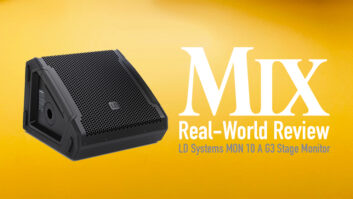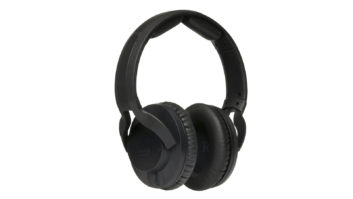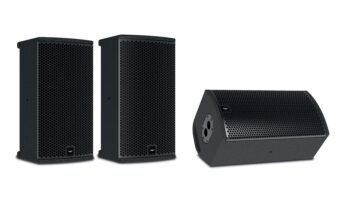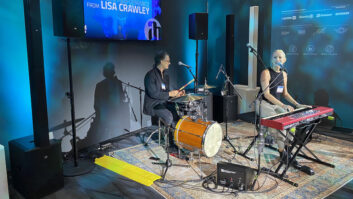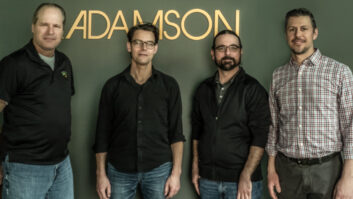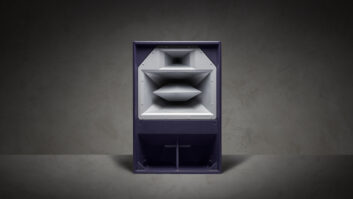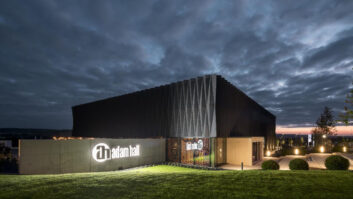Digitally beam-steerable loudspeaker arrays, such as Meyer Sound’s CAL system, installed at Trinity Lutheran Church in Spring, TX, can provide greater speech intelligibility than alternative speaker solutions in acoustically challenging house of worship environments.
Digitally beam-steerable loudspeaker arrays offer a number of unique capabilities in house of worship applications, where the architecture can present significant challenges to the delivery of intelligible speech.

Highly reverberant spaces, in particular, such as Old World-style stone churches or structures with large expanses of glass, can especially benefit from beam-steered arrays, which can offer greater speech intelligibility compared to more traditional large line arrays or distributed systems.
As Duran Audio—the company that manufactured and installed the first digitally-controlled beam steering speakers in 1994 at Amsterdam’s Schipol Airport—has noted in technical literature for the company’s Intellivox product, each speaker, or group of speakers, in a beam-steered array can have its own set of filters. This enables the vertical dispersion to be very tightly controlled using DSP (Digital Signal Processing), allowing each beam to be steered away from reflective surfaces and thus reduce unwanted reverberation. The result is a high ratio of direct-to-reverberant sound, greatly improving speech intelligibility.
“Beam steering allows us to create very, very tight beams of sound—in our case, as tight as five degrees,” reports Rik Kirby, vice president of sales and marketing, Renkus-Heinz. “Certainly in our product—which is one of the things that differentiates us from the others—we can create many beams from a single column. So we can have a separate beam for the back of the room, middle of the room, front of the room, middle balcony and top balcony. It allows us to maintain very consistent frequency response and, in many ways, more importantly, level in the intended listening area.”
Beam steering products can offer very fine coverage control. “In a three-meter column, we can get up to 12 beams. In our two-meter column, eight beams,” says Kirby. “The additional granularity we have with multiple beams really allows you to fine-tune to the environment.”
Renkus-Heinz offers a range of beamsteerable products, from the Iconyx, which is best suited to speech and light music, to IC Live, featuring higher power 6.5-inch neodymium subwoofers and 1-inch exit, 2.5-inch diaphragm compression drivers, to IC2, “which is for all intents and purposes a medium format line array,” according to Kirby. “IC2 is used for churches that have a more full-on, rock ‘n’ roll-type service.”
Early beam-steering products were more concerned with speech intelligibility than full-bandwidth content, observes Graham Hendry, VP, application engineering and technology (AET) group, TC Group International. “It’s the length of the column that dictates the low frequency control, and it’s the dense spacing of the high-frequency elements that allows you high-frequency control,” he explains, adding, “If you look at the advantages over standard distributed systems, there are fewer maintenance points, and they cover areas with even SPL from front to back with just a single column.”
Tannoy’s beam steering system, QFlex, is a modular system, says Hendry. It ranges from QFlex 16, encompassing eight 3-inch and eight 1-inch drivers in a column measuring 29 inches high, to QFlex 64, which is 18 feet tall, housing 16 each of the 3-inch and 1-inch drivers, plus 32 four-inch drivers. “Where in the past maybe people were happy to have control up to 4 kHz, we decided that we wanted it to be full bandwidth. When someone says, ‘It’s just speech, it can be band-limited,’ it’s not entirely true, because you’re still dealing with consonants. It’s definitely an advantage to have full-frequency steering,” says Hendry.
However, speech reproduction can often be an afterthought, he says. “When you’re designing these systems, probably music reproduction has too much influence over the design. The perception is that if the music sounds good, then so will the speech.”
Some people believe Duran Audio (now part of JBL), as the first to market with a steerable speaker, is old fashioned, says Nick Screen, sales director, Duran Audio. “The physical look of the product has never changed, but a lot has happened under the hood. We’ve moved way beyond beam steering to beam shaping now. We have both nearfield and farfield control for the array, which means we can really shape the dispersion to fit any room geometry and get the best direct-to-room ratio, while at the same time covering the audience properly.”
The Intellivox system, with models offering beam steering or beam shaping, are available in five lengths, from a little under four feet to over 16 feet. Most models feature 4-inch drivers, but there are some models available with 6.5-inch drivers instead, and several models with horn arrays that extend response to 18 kHz. “We can have up to eight different presets within Intellivox,” adds Screen. “If you have a room which, for whatever reason, is flexible in its usage, you can change the beam shape or the EQ, or the volume control to fit those scenarios.”
Meyer Sound’s CAL (Column Array Loudspeaker) comes in three sizes, offering a total of 32, 64 or 96 4-inch woofers and 1-inch tweeters in various combinations. The columns are respectively 54, 88 and 121 inches in height. “With the CAL speaker, you have an individual channel of DSP for every single speaker, and also an individual amplifier for every single speaker,” says Joe Villaveces, design services coordinator, Meyer Sound. “That ends up being an important distinction, because you get a lot more control over what you’re doing.”
A column of 4-inch drivers might be able to reproduce 20 kHz, says Villaveces, “but because of the wavelength and the relatively wide spacing of 4-inch drivers, you just can’t steer up there—it’s physically impossible. But CAL gives you a good spacing so you can steer really well up to about 8k, 10k or so.”
The beam can be split and steered independently, he continues. “We just did a demo in a place where they had some side balconies and ended up taking a CAL 64 and shooting it at the upper and lower balconies. It split very well.”
As with other steerable solutions, CAL is controlled through software—in this case, Meyer Sound’s Compass package. “If you’re doing beam splits, you can change level, delay and equalization—it has a five-band EQ built into it,” says Villaveces. Since steerable products are self-contained, with all DSP and amplification on-board, requiring just one or two cables to a cabinet, installation can be very simple, offering cost savings compared to other solutions.
Hendry offers some words of caution. “Some people think putting any old beam steering speaker in there is going to cure all ills. If you consider reverberation time, if it’s four seconds, it’s important to look at where it’s four seconds. The midband or the low end? I’ve seen people put in a QFlex 16 that has control down to 700 Hz where the RT is peaking at 100, 120 Hz. It’s not making any difference at all.”
Speech intelligibility—usually the goal behind installing a steerable solution—can be specified in advance, designed for and objectively measured, continues Hendry. “But not everyone is capable of doing that. There’s no substitute for a good grounding in acoustic measurement and computer-based modeling when designing these systems.
“If you’re a contractor or a consultant who has invested significant resources into learning audio acoustics, you should go one step further and market speech intelligibility as a product. It’s better for business.”

